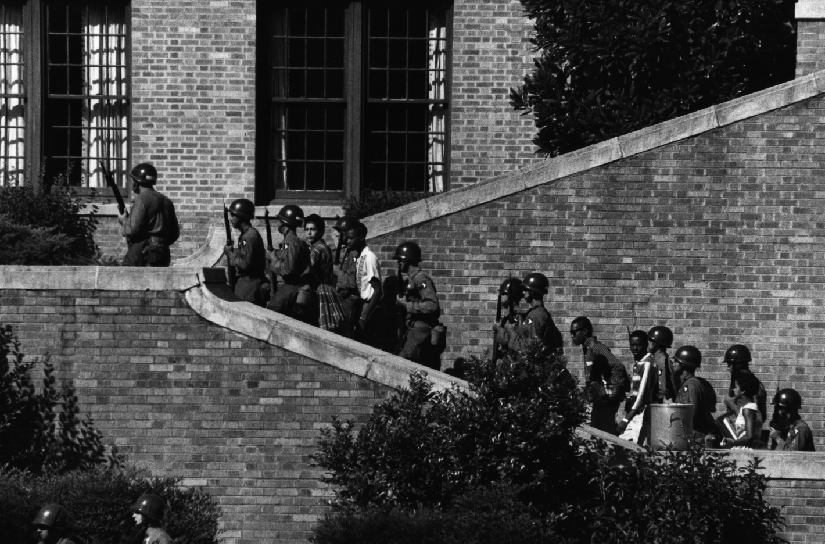| << Chapter < Page | Chapter >> Page > |
The Court relies on the executive to implement or enforce its decisions and on the legislative branch to fund them. As the Jackson and Lincoln stories indicate, presidents may simply ignore decisions of the Court, and Congress may withhold funding needed for implementation and enforcement. Fortunately for the courts, these situations rarely happen, and the other branches tend to provide support rather than opposition. In general, presidents have tended to see it as their duty to both obey and enforce Court rulings, and Congress seldom takes away the funding needed for the president to do so.
For example, in 1957, President Dwight D.
Eisenhower called out the military by executive order to enforce the Supreme Court’s order to racially integrate the public schools in Little Rock, Arkansas. Eisenhower told the nation: “Whenever normal agencies prove inadequate to the task and it becomes necessary for the executive branch of the federal government to use its powers and authority to uphold federal courts, the president’s responsibility is inescapable.”

So what becomes of court decisions is largely due to their credibility, their viability, and the assistance given by the other branches of government. It is also somewhat a matter of tradition and the way the United States has gone about its judicial business for more than two centuries. Although not everyone agrees with the decisions made by the Court, rulings are generally accepted and followed, and the Court is respected as the key interpreter of the laws and the Constitution. Over time, its rulings have become yet another way policy is legitimately made and justice more adequately served in the United States.
Like the executive and legislative branches, the judicial system wields power that is not absolute. There remain many checks on its power and limits to its rulings. Judicial decisions are also affected by various internal and external factors, including legal, personal, ideological, and political influences. To stay relevant, Court decisions have to keep up with the changing times, and the justices’ decision-making power is subject to the support afforded by the other branches of government in implementation and enforcement. Nevertheless, the courts have evolved into an indispensable part of our government system—a separate and coequal branch that interprets law, makes policy, guards the Constitution, and protects individual rights.
Books written by current and former justices:
Breyer, Stephen. 2006. Active Liberty: Interpreting the Democratic Constitution . New York: Vintage; 2010; Making Democracy Work: A Judge’s View. New York: Knopf.
O’Connor, Sandra Day. 2004. The Majesty of the Law: Reflections of a Supreme Court Justice . New York: Random House.
Rehnquist, William. 2002. The Supreme Court . New York: Vintage.
Scalia, Antonin. 1998. A Matter of Interpretation: The Federal Courts and the Law . Princeton, NJ: Princeton University Press.
Sotomayor, Sonia. 2014. My Beloved World . New York: Vintage Books.
Stevens, John Paul. 2011. Five Chiefs: A Supreme Court Memoir . New York: Little, Brown.
Thomas, Clarence. 2008. My Grandfather’s Son: A Memoir . New York: Harper.
Books about the U.S. court system:
Coyle, Marcia. 2013. The Roberts Court: The Struggle for the Constitution . New York: Simon and Schuster.
Ferguson, Andrew G. 2013. Why Jury Duty Matters: A Citizen’s Guide to Constitutional Action . New York: New York University Press.
Millhiser, Ian. 2015. Injustices: The Supreme Court’s History of Comforting the Comfortable and Afflicting the Afflicted . New York: Nation Books.
Peppers, Todd C., and Artemus Ward. 2012. In Chambers: Stories of Supreme Court Law Clerks and Their Justices . Charlottesville: University of Virginia Press.
Tobin, Jeffrey. 2012. The Oath: The Obama White House and the Supreme Court . New York: Doubleday.
Vile, John R. 2014. Essential Supreme Court Decisions: Summaries of Leading Cases in U.S. Constitutional Law , 16th ed. Lanham: Rowman&Littlefield.
Films:
1981. The First Monday in October .
1993. The Pelican Brief .
HBO. 2000. Recount .
2015. Confirmation.
2015. On the Basis of Sex .

Notification Switch
Would you like to follow the 'American government' conversation and receive update notifications?